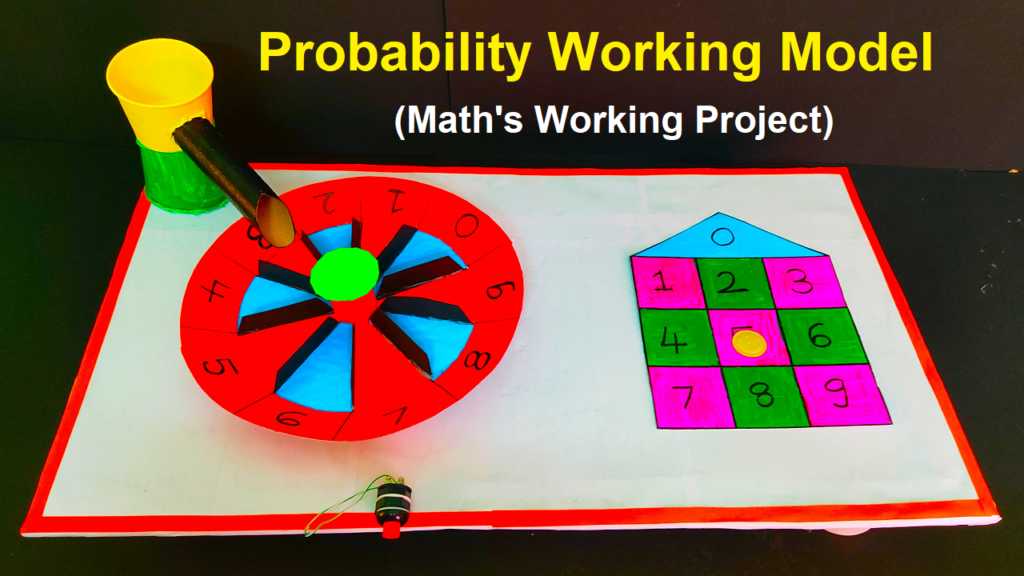Probability is a fascinating branch of mathematics that helps us understand the likelihood of different outcomes in uncertain situations.
To make learning about probability engaging and interactive, we’ve created a hands-on working model game.
Game Concept:
In this game, we’ll be using a spinning wheel to simulate various random events. The wheel is divided into numbered sections, each representing a different possible outcome.

Players will place bets on which number they think the wheel will land on.
Creating a probability working model game using cardboard, a DC motor for rotation, coins, and numbers can be a fun and educational project.
Here are the steps to make it:
Materials Needed:
- Cardboard sheets
- DC motor with a small propeller
- Small wooden or plastic coins
- Number stickers or markers
- Glue
- Wires
- Battery or power source for the motor
- Switch (optional)
- Hot glue gun (optional)
Steps by Steps Video Instructions:
- Create the Base:
- Start by cutting a large circular piece of cardboard to serve as the base of your game. This will be the spinning wheel.
- Attach the DC Motor:
- Glue or secure the DC motor in the center of the cardboard base. Make sure it is firmly attached and can rotate the base.
- Create Numbered Sections:
- Divide the cardboard circle into several equal sections. You can create these sections by cutting and gluing smaller cardboard pieces onto the base. Each section should have a number from 1 to the maximum number of sections you want (e.g., 1 to 6 for a simple dice game).
- Attach Coins:
- Glue the coins to the edge of each section. Make sure they are evenly spaced. These coins will act as pointers to select a section when the wheel spins.
- Label the Coins:
- Add number stickers or write numbers on the coins corresponding to the sections they are attached to. Each number represents an outcome or event in your probability game.
- Wire the Motor:
- Connect wires to the DC motor and ensure they are long enough to connect to a power source. You may need to solder the wires to the motor terminals for a secure connection.
- Test the Rotation:
- Test the rotation of your wheel by connecting the wires to a battery or power source. The wheel should spin when the motor is powered.
- Game Rules:
- Define the rules of your probability game. For example, players can place bets on which number the wheel will land on. You can assign different payouts based on the probability of landing on each number.
- Optional: Add a Switch:
- You can add an on/off switch in the circuit to control when the wheel spins. This gives you better control over the game.
- Decorate (Optional):
- You can decorate the cardboard base to make it visually appealing. Paint it, add colorful designs, or cover it with paper to enhance the aesthetics.
- Play and Learn:
- Invite friends or family to play the game and explore the concept of probability by observing which numbers come up most frequently.
This DIY probability working model game can be a great educational tool for understanding basic probability concepts through hands-on experience. It’s not only informative but also a lot of fun!
Working Principle:
The probability game with coins and a rotating wheel demonstrates key concepts in probability and randomness:
- Randomness and Fairness:
- The spinner provides a random outcome each time it is spun, demonstrating the concept of random events.
- Each section of the wheel has an equal probability of being landed on if the wheel is divided equally and spun fairly. For an 8-section wheel, each section has a 1/8 (or 12.5%) chance of being landed on.
- Probability Calculation:
- Players can calculate the probability of landing on a specific section or a type of section (e.g., winning a coin or losing a coin). This introduces basic probability concepts and encourages strategic thinking.
- Expected Outcomes:
- Over many spins, the outcomes should reflect the probabilities of each section. For example, if half of the sections result in winning a coin and the other half in losing a coin, players will start to see these probabilities play out over time.
- Decision Making and Risk:
- Players make decisions based on the potential outcomes and their current standing in the game. This adds an element of strategy and understanding of risk versus reward.
Example Game Rules:
- Winning a Coin:
- Sections 1, 3, 5, and 7 allow the player to win 1 coin.
- Losing a Coin:
- Sections 2, 4, 6, and 8 require the player to lose 1 coin.
- Special Actions (Optional):
- Add special actions to certain sections, such as “Steal a coin from another player” or “Skip your next turn.”
Playing the Game:
- Each player starts with 10 coins.
- Players take turns spinning the wheel.
- If the wheel lands on a section where they win a coin, they take a coin from the central bank.
- If the wheel lands on a section where they lose a coin, they return a coin to the central bank.
- The first player to collect 20 coins, or the player with the most coins after a set number of rounds, wins the game.

